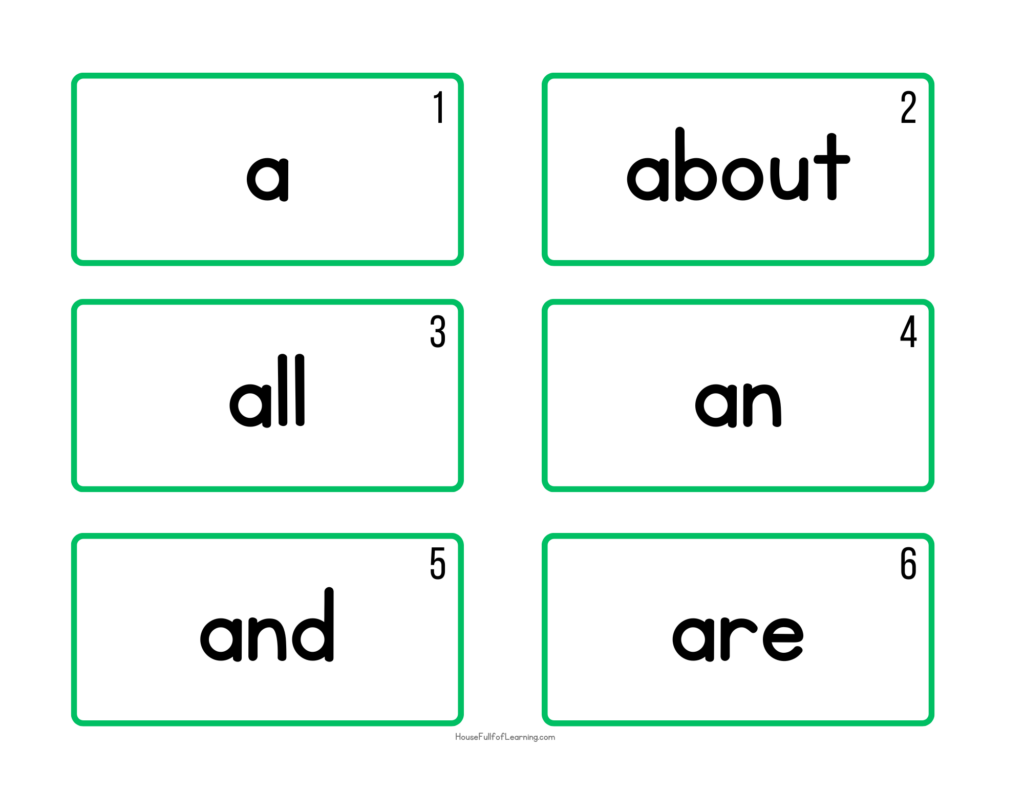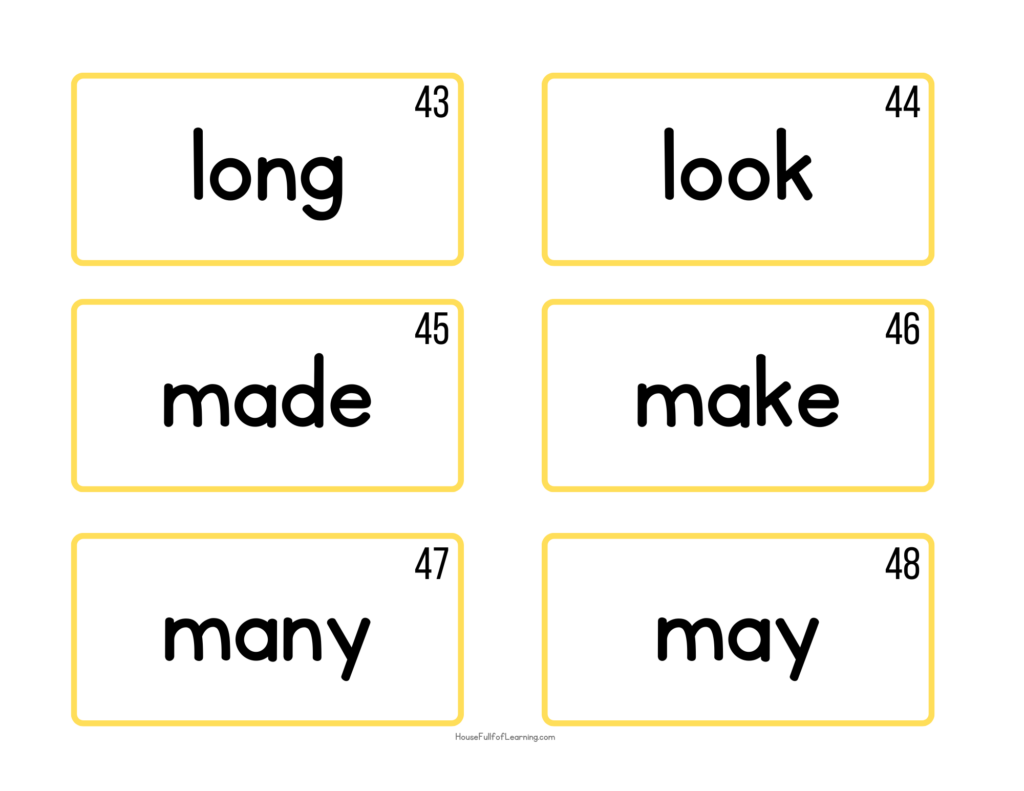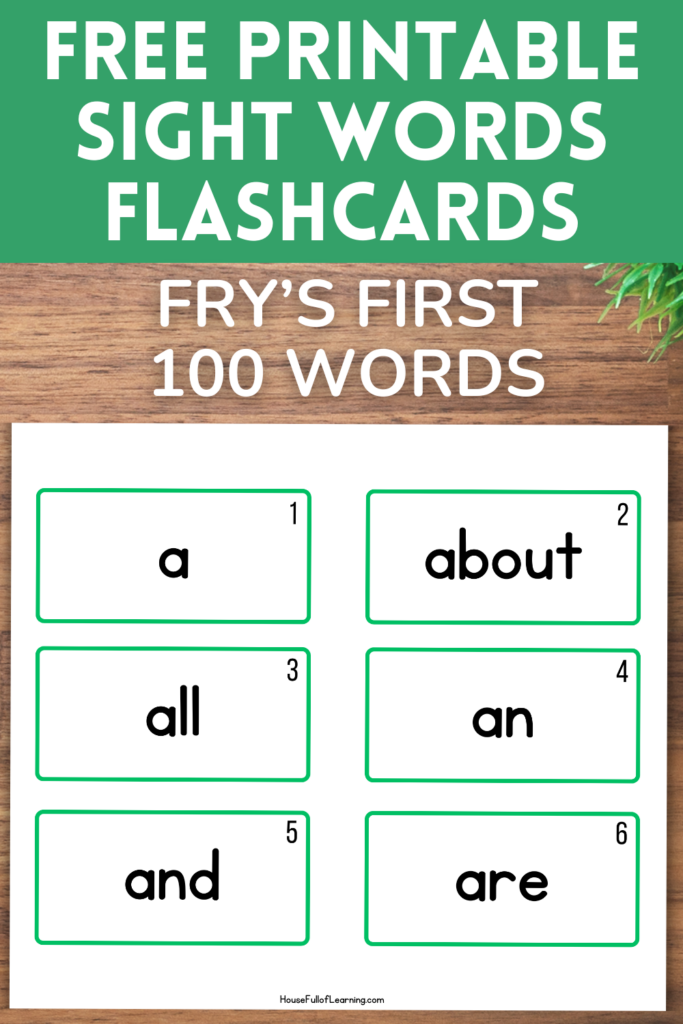Help your kids learn their sight words with these printable sight word flashcards!
After your child recognizes the alphabet and knows the sounds each letter makes, learning sight words is an important next step on the path to reading.
You might have even heard that more than 50% of the words in Children’s books are sight words.
So, I’ve included a free downloadable set of numbered flashcards with Fry’s First 100 words in colored and black frames so you can easily organize them by groups.
It’s one of the most commonly used lists (along with the Dolch Sight Word lists) to help preschool through elementary-age kids learn important words that will build their reading fluency.
As a veteran elementary school teacher with a Master’s degree as a Reading Specialist, I’ve seen firsthand how important these words are for young readers to know.
So if you’re homeschooling or supporting your child as s/he learns to read, you’ll find these no-prep sightword flashcards plus some tips and info to bring you up to speed on how crucial these words are for children to learn.
Are they sight words or high-frequency words?

Admittedly, it’s a little confusing at first glance. But it’s important to recognize the difference if you want to help your child use all possible tools when reading these words.
Sight words are words that can’t be sounded out like: the, said, was, they. They break all the phonics rules and are easiest when they are recognized by sight.
If you’ve ever sat with a child trying to sound out these words, you can see how frustrating and tiresome it is for young kids who don’t understand these rule-breakers.
High-frequency words are as they sound, words that appear often in written texts. Sight words can also be, and usually are, high-frequency words. But you’ll also notice high-frequency words that aren’t sight words on sight word lists.
These are words like and, can, with, jump. You can easily see how common these words are and that they DO follow phonics rules, too.
Does this difference really matter?
Generally speaking, I would say no. If your child learns to recognize sight words and high-frequency words instantly, this will have an incredibly positive impact on their overall reading fluency as they increase their reading level.
Think of it this way. As your child reads, their brain will dedicate the resources it needs to decipher and decode the words on the page.
If a word is instantly recognized, those resources are used on other things like figuring out more complex words and reading comprehension. In the end, sight words and high-frequency words won’t be what tires them out.
BUT, everyone learns differently. Not all children have an easy time memorizing what sight words and high-frequency words look like. So, it’s beneficial to point out and even develop a strategy around high-frequency words that can be sounded out.
Your child is learning phonics so show them how these tools can be used to help them with these words, especially if they’re struggling to recognize these words as a whole unit.
Which sight word lists should I use?
The Fry Sight Word lists are broken into 10 lists of 100 words each. The first 300 of these words are the most important for kids in Kindergarten through 3rd grade.
The Dolch Sight Word lists are a set of 220 words broken into lists from Preschool to 3rd grade.
Most schools will use one or the other or possibly a combination of the two.
If you look, you’ll notice a good amount of overlap between the lists. So, there’s not a wrong choice if you’re unsure.
How should you help your child learn sight words?

Flashcards are really helpful here, along with a variety of games and activities.
I introduce each word individually, reading it aloud, showing what it looks like, and talking about things to notice, relevant phonics, or any helpful tricks. In a given period of time, my class and I focus on 10-20 words, learning a few at a time until we finish the set.
These words are practiced with written work and activities and incorporated into games, multi-sensory activities, everyday read-alouds, and play.
Some things in school are inherently fun and interesting to learn. It’s not surprising that memorizing sight words might not be what your child was most jazzed up about at school!
If you’re working on learning these words at home, make it fun! Here are a few ideas.
- Use the flashcards to learn and practice.
- Incorporate written sight word work with activity pages.
- Play sight word BINGO.
- Use the flashcards (2 sets) instead of cards to play a game of Memory or Go Fish.
- Make the sight words out of playdough.
- Write the words in chalk or paint or use magnetic letters to make them.
- Do word searches specifically for sight word practice.
- Write them on trays covered in shaving cream.
- Incorporate body movements to help remember the letters in each word.
- Use your finger to write the word on your child’s back and see if they can figure out the sight word.
What if your child is having trouble learning sight words?
First and foremost, be patient. It’s de-motivating to feel like something is too hard and that negative experience can leave a mark that could cast reading in a bad light for your kids.
(Remember feeling like you “weren’t good” at something in school? If you’re like me, you probably tried to avoid it whenever you could.)
If your child is in Pre-K or even earlier and they’re resistant to sight word work, it’s ok to put it off for a while and come back to it at another time.
If your child is in Kindergarten or first grade, lean into the game ideas above. There are no rules against starting with a fun activity and then incorporating activity pages and written work later when they have more confidence.
In some cases, I’ve worked with individual students as they dictated a few simple sentences about something they recently did.
For example: My dad and I had pizza. Then, we went outside to play with Max, our dog. Then, it was time for bed.
As the child talks, I write what they say down on big chart paper or a dry-erase board. Then, we practice reading it back together. Even a struggling reader will be able to read most of this because they just said it and it’s actually something that happened in their life.
Without even realizing it, your child will be practicing 15 sight words. Not to mention how empowering it’ll feel for them to realize they CAN read what you wrote!
Download these First 100 Fry Sight Word Flashcards
Just click here to get your free downloadable PDF with2 sets of the First 100 Fry Sight Words.
Cut them out. Laminate them, if you’d like. Then, attach them to a binder ring so you can easily flip through or sort them into groups.
I hope you and your child find these flashcards helpful. Happy learning!
Like this post? Please share it on Pinterest or use the share buttons to share it on social media.


Leave a Reply